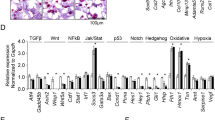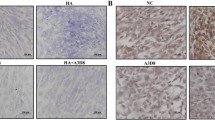Abstract
In chondrogenic differentiation, expression and collaboration of specific molecules, such as aggrecan and type II collagen, in extracellular matrix (ECM) are crucial. However, few studies have clarified the roles of hyaluronan (HA) in proteoglycan aggregation during chondrogenic differentiation. We assessed the roles of HA in sulfated glycosaminoglycans deposition during chondrogenic differentiation by means of 4-methylumbelliferone (4-MU), an HA synthase inhibitor, using ATDC5 cells. ATDC5 cells were treated with 0.5 mM 4-MU for 7 or 21 days after induction of chondrogenic differentiation with insulin. Depositions of sulfated glycosaminoglycans were evaluated with Alcian blue staining. mRNA expression of ECM molecules was determined using real-time RT-PCR. The deposition of aggrecan and versican was investigated with immunohistochemical staining using specific antibodies. Effects of 4-MU on HA concentrations were analyzed by HA binding assay. 4-MU suppressed the positivity of Alcian blue staining, although this delay was reversible. Interestingly, stronger positivity of Alcian blue staining was observed at day 21 in cultures with 4-MU discontinuation than in the control. 4-MU significantly increased the mRNA expression of aggrecan, versican, and type II collagen, which was consistent with increased deposition of aggrecan and versican. The HA concentration in ECM and cell-associated region was significantly suppressed with 4-MU treatment. We conclude that the inhibition of HA synthesis slows sulfated glycosaminoglycans deposition during chondrogenic differentiation despite the increased deposition of other ECM molecules. Transient starvation of HA with 4-MU accelerates chondrogenic ECM formation, suggesting its potential to stimulate chondrogenic differentiation with adequate use.







Similar content being viewed by others
References
Arai E, Nishida Y, Wasa J, Urakawa H, Zhuo L, Kimata K, Kozawa E, Futamura N, Ishiguro N (2011) Inhibition of hyaluronan retention by 4-methylumbelliferone suppresses osteosarcoma cells in vitro and lung metastasis in vivo. Br J Cancer 105(12):1839–1849. doi:10.1038/bjc.2011.459
Atsumi T, Miwa Y, Kimata K, Ikawa Y (1990) A chondrogenic cell line derived from a differentiating culture of AT805 teratocarcinoma cells. Cell Differ Dev 30(2):109–116
Clarkin CE, Allen S, Wheeler-Jones CP, Bastow ER, Pitsillides AA (2011) Reduced chondrogenic matrix accumulation by 4-methylumbelliferone reveals the potential for selective targeting of UDP-glucose dehydrogenase. Matrix Biol 30(3):163–168. doi:10.1016/j.matbio.2011.01.002
Frost GI, Csoka AB, Wong T, Stern R (1997) Purification, cloning, and expression of human plasma hyaluronidase. Biochem Biophys Res Commun 236(1):10–15
Goldring MB, Tsuchimochi K, Ijiri K (2006) The control of chondrogenesis. J Cell Biochem 97(1):33–44. doi:10.1002/jcb.20652
Hardingham TE, Fosang AJ (1992) Proteoglycans: many forms and many functions. FASEB J 6(3):861–870
Hascall VC, Heinegard D (1974) Aggregation of cartilage proteoglycans. I. The role of hyaluronic acid. J Biol Chem 249(13):4232–4241
Julovi SM, Yasuda T, Shimizu M, Hiramitsu T, Nakamura T (2004) Inhibition of interleukin-1beta-stimulated production of matrix metalloproteinases by hyaluronan via CD44 in human articular cartilage. Arthritis Rheum 50(2):516–525. doi:10.1002/art.20004
Kakizaki I, Kojima K, Takagaki K, Endo M, Kannagi R, Ito M, Maruo Y, Sato H, Yasuda T, Mita S, Kimata K, Itano N (2004) A novel mechanism for the inhibition of hyaluronan biosynthesis by 4-methylumbelliferone. J Biol Chem 279(32):33281–33289. doi:10.1074/jbc.M405918200
Kimata K, Oike Y, Tani K, Shinomura T, Yamagata M, Uritani M, Suzuki S (1986) A large chondroitin sulfate proteoglycan (PG-M) synthesized before chondrogenesis in the limb bud of chick embryo. J Biol Chem 261(29):13517–13525
Knudson CB, Knudson W (1993) Hyaluronan-binding proteins in development, tissue homeostasis, and disease. FASEB J 7(13):1233–1241
Knudson CB, Toole BP (1985) Changes in the pericellular matrix during differentiation of limb bud mesoderm. Dev Biol 112(2):308–318
Knudson W, Bartnik E, Knudson CB (1993) Assembly of pericellular matrices by COS-7 cells transfected with CD44 lymphocyte-homing receptor genes. Proc Natl Acad Sci USA 90(9):4003–4007
Kultti A, Pasonen-Seppanen S, Jauhiainen M, Rilla KJ, Karna R, Pyoria E, Tammi RH, Tammi MI (2009) 4-Methylumbelliferone inhibits hyaluronan synthesis by depletion of cellular UDP-glucuronic acid and downregulation of hyaluronan synthase 2 and 3. Exp Cell Res 315(11):1914–1923. doi:10.1016/j.yexcr.2009.03.002
Laurent TC, Fraser JR (1992) Hyaluronan. FASEB J 6(7):2397–2404
Maleski MP, Knudson CB (1996) Hyaluronan-mediated aggregation of limb bud mesenchyme and mesenchymal condensation during chondrogenesis. Exp Cell Res 225(1):55–66. doi:10.1006/excr.1996.0156
Nishida Y, Knudson CB, Nietfeld JJ, Margulis A, Knudson W (1999) Antisense inhibition of hyaluronan synthase-2 in human articular chondrocytes inhibits proteoglycan retention and matrix assembly. J Biol Chem 274(31):21893–21899
Nishida Y, Knudson CB, Eger W, Kuettner KE, Knudson W (2000) Osteogenic protein 1 stimulates cells-associated matrix assembly by normal human articular chondrocytes: up-regulation of hyaluronan synthase, CD44, and aggrecan. Arthritis Rheum 43(1):206–214. doi:10.1002/1529-0131(200001)43:1<206:AID-ANR25>3.0.CO;2-1
Nishida Y, Knudson CB, Knudson W (2004) Osteogenic protein-1 inhibits matrix depletion in a hyaluronan hexasaccharide-induced model of osteoarthritis. Osteoarthr Cartil 12(5):374–382. doi:10.1016/j.joca.2004.01.008
Rilla K, Pasonen-Seppanen S, Rieppo J, Tammi M, Tammi R (2004) The hyaluronan synthesis inhibitor 4-methylumbelliferone prevents keratinocyte activation and epidermal hyperproliferation induced by epidermal growth factor. J Invest Dermatol 123(4):708–714. doi:10.1111/j.0022-202X.2004.23409.x
Schwartz NB, Lyle S, Ozeran JD, Li H, Deyrup A, Ng K, Westley J (1998) Sulfate activation and transport in mammals: system components and mechanisms. Chem Biol Interact 109(1–3):143–151
Schwartz Z, Griffon DJ, Fredericks LP, Lee HB, Weng HY (2011) Hyaluronic acid and chondrogenesis of murine bone marrow mesenchymal stem cells in chitosan sponges. Am J Vet Res 72(1):42–50. doi:10.2460/ajvr.72.1.42
Shibata S, Fukada K, Imai H, Abe T, Yamashita Y (2003) In situ hybridization and immunohistochemistry of versican, aggrecan and link protein, and histochemistry of hyaluronan in the developing mouse limb bud cartilage. J Anat 203(4):425–432
Shinomura T, Nishida Y, Ito K, Kimata K (1993) cDNA cloning of PG-M, a large chondroitin sulfate proteoglycan expressed during chondrogenesis in chick limb buds. Alternative spliced multiforms of PG-M and their relationships to versican. J Biol Chem 268(19):14461–14469
Shukunami C, Shigeno C, Atsumi T, Ishizeki K, Suzuki F, Hiraki Y (1996) Chondrogenic differentiation of clonal mouse embryonic cell line ATDC5 in vitro: differentiation-dependent gene expression of parathyroid hormone (PTH)/PTH-related peptide receptor. J Cell Biol 133(2):457–468
Suzuki A, Tanimoto K, Ohno S, Nakatani Y, Honda K, Tanaka N, Doi T, Ohno-Nakahara M, Yoneno K, Ueki M, Tanne K (2005) The metabolism of hyaluronan in cultured rabbit growth plate chondrocytes during differentiation. Biochim Biophys Acta 1743(1–2):57–63. doi:10.1016/j.bbamcr.2004.08.007
Toole BP (1997) Hyaluronan in morphogenesis. J Intern Med 242(1):35–40
Urakawa H, Nishida Y, Wasa J, Arai E, Zhuo L, Kimata K, Kozawa E, Futamura N, Ishiguro N (2012) Inhibition of hyaluronan synthesis in breast cancer cells by 4-methylumbelliferone suppresses tumorigenicity in vitro and metastatic lesions of bone in vivo. Int J Cancer 130(2):454–466. doi:10.1002/ijc.26014
Yoshikawa K, Kitamura N, Kurokawa T, Gong JP, Nohara Y, Yasuda K (2013) Hyaluronic acid affects the in vitro induction effects of synthetic PAMPS and PDMAAm hydrogels on chondrogenic differentiation of ATDC5 cells, depending on the level of concentration. BMC Musculoskelet Disord 14:56. doi:10.1186/1471-2474-14-56
Zhu L, Zhuo L, Kimata K, Yamaguchi E, Watanabe H, Aronica MA, Hascall VC, Baba K (2010) Deficiency in the serum-derived hyaluronan-associated protein-hyaluronan complex enhances airway hyperresponsiveness in a murine model of asthma. Int Arch Allergy Immunol 153(3):223–233. doi:10.1159/000314362
Acknowledgments
The authors thank Ms. Eri Ishihara for secretarial assistance. This work was supported in part by the Ministry of Education, Culture, Sports, Science and Technology of Japan [Grant-in-Aid 20591751 for Scientific Research (C)], and by the Suzuken Memorial Foundation. Funding sources had no role in the study design, collection, analysis, and interpretation of data; in the writing of the manuscript; and in the decision to submit the manuscript for publication.
Author information
Authors and Affiliations
Corresponding author
Electronic supplementary material
Below is the link to the electronic supplementary material.
Fig. S1
Effect of 4-MU on mRNA expression of UDP-glucose dehydrogenase (UGDH) in cultured ATDC5 cells at day 0–day 21. The data depict relative mRNA expression standardized by that of GAPDH. Error bars express ± standard error of mean (S.E.M.) (TIFF 112 kb)
Rights and permissions
About this article
Cite this article
Yoshioka, Y., Kozawa, E., Urakawa, H. et al. Inhibition of hyaluronan synthesis alters sulfated glycosaminoglycans deposition during chondrogenic differentiation in ATDC5 cells. Histochem Cell Biol 144, 167–177 (2015). https://doi.org/10.1007/s00418-015-1325-3
Accepted:
Published:
Issue Date:
DOI: https://doi.org/10.1007/s00418-015-1325-3




